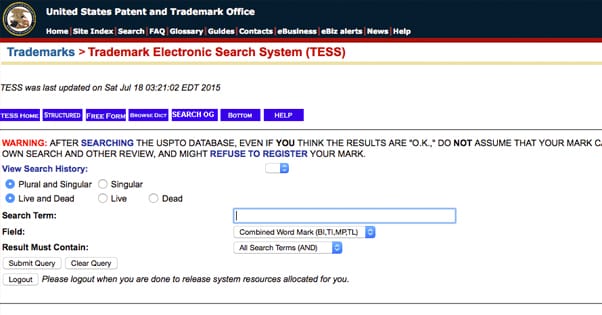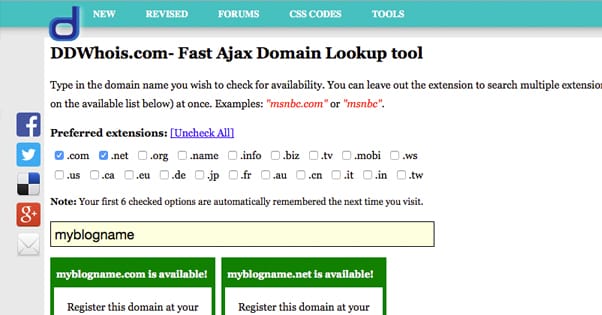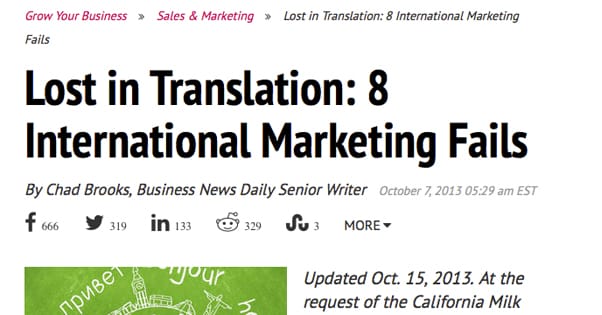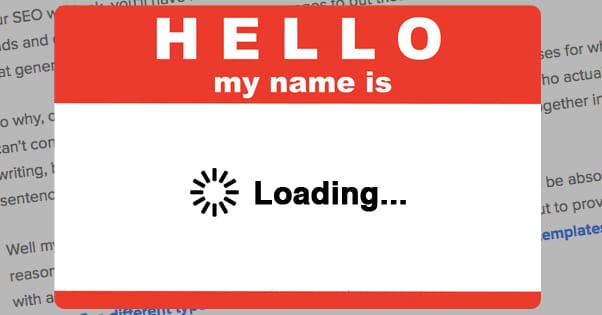Starting a Blog: How to Come up with a Name for Your Blog
Published by Kenny Novak • Content Marketing • Posted July 18, 2015 ContentPowered.com
ContentPowered.com
Perhaps one of the most formative and pivotal decisions you can make when you’re starting a blog is the choice of name. Blogs all throughout the Internet have all sorts of names, from firstnamelastname.com to brandname.com to acronyms to nonsensical phrases and mashups of words. Some use alternative top-level domains to make amusing words without the .com, like del.icio.us used to.
There’s a lot of power in a name, and it’s a choice you want to make correctly. With that in mind, I’ve compiled a list of concerns you should think about when you’re coming up with a blog name. Some of them may not apply to you, and some of them can be overridden with a good enough blog, unique design, and high quality content.
Others, though, are more crucial to the success of your blog.
Brand Recognition

This is why you can’t generally choose a generic name. If you were to try to build a brand around the blog name “Content Creator” you could probably do it – see sites like ProBlogger – but it would take a hell of a lot of time, effort, and energy. On the other hand, a more distinctive brand name gives readers something memorable to latch onto and come back to later. Making something memorable is big.
Think of any big name site that exists today. Facebook, Imgur, Reddit, Tumblr; they’re all short, memorable names. Think about large blogs, like Mashable, Gizmodo, Gawker, Tech Crunch; still memorable, original names. You don’t see ultra-generic names on that list. There’s one related concern, and it’s a big one; what’s the name of your company going to be, assuming you create a company to manage your blog? Are you just going to go with your name as an LLC, or are you going to make your blog name the company name?
You can go with a third option and make an unrelated LLC, which people like Neil Patel do, but that does tend to make things more complicated. This means you need to do some research into existing companies. You never know what has already been registered as an LLC somewhere, thus making you unable to claim the name as your business name.
While this doesn’t necessarily prevent you from naming your blog the same thing, it does open you up to potential trademark infringement, which would force you to make a significant change to your business, or at least defend it in court. 
Unfortunately, no such central database exists. You’ll have to follow a more complex process to search.
- First, just do a simple name search on Google. If the company exists publicly, chances are they should show up under a search.
- If you need to dig deeper, you’ll want to go to your county clerk. You can usually find them in city hall, though this varies from place to place. The clerk will be able to direct you to something called a fictitious name database. This will tell you if the company name you’re looking for is registered but not really in use, or if it’s an assumed trademark of a large company. For example, you couldn’t trademark Coke, because Coca-Cola owns it, even if it’s not the actual name of their company.
- While you’re talking to this clerk, you’ll want to run a search in your state’s LLC or Limited Partnership database. If your proposed name shows up there, you can’t use it.
- You can also search the United States Patent and Trademark Office database, which should have a relatively complete list of registered trademarks. You don’t want to be the target of legal action for trying to use a registered trademark that you could have found through this public search.
- There are a few other options you can take, listed at the link above. The Thomas Register is one such resource, as is networksolutions.com.
URL Concerns

Just like brand names can be subject to trademarks and thus be unavailable, URLs can be registered by companies and be unavailable. Sometimes they’re registered and parked, and available for sale if you pay enough. Sometimes they’re registered and protected, specifically to keep anyone else from obtaining them. MarkMonitor is a company specializing in doing just that. A domain owned and parked by that company will be unavailable for the foreseeable future. In other cases, the domain you want might be registered so it can redirect to a different domain.
Google owns www.gooogle.com, for example, so no one can poach traffic caused by a typo. In other cases, a site may have moved and maintains the registration on their old domain, even if they haven’t used that branding for years. Moz owns www.seomoz.com for that reason, and it redirects to their new site. There are other cases where a domain you want may be free and open, but is very close to an existing domain.
If you wanted www.smoz.com, you could buy it; it’s parked and available to buy. According to who.is, the company that has it parked wants $63,250 for it, but that may or may not be accurate. In any case, most of the value of that URL comes from it being an old 4-letter domain, making it not quite a good example. Still, you wouldn’t want that URL because it’s pretty close to Moz and SEOMoz, and they might take umbrage.
This is a particular risk if you’re trying to start a blog about SEO, where you might be stepping on toes. If Smoz was a food blog, well, they probably wouldn’t care. Then again, I’m not sure Smoz is a good name for a food blog; the word sounds kind of grubby, and isn’t really the kind of mental feeling I would want associated with food. Another concern with URL is top level domain. You’ll recognize these as the .com, the .org, the .net, and all the rest.
What you might not know is that there are 1,000 of these. There’s the normal TLDs you know and love, and the country code TLDs like .us and .co.uk and .ca. Then there are all of the more ridiculous new TLDs introduced in the last few years, to try to ease the problem of overcrowding on the .com channel.
Is www.blogname.com taken? Why not go with www.blogname.legal, or www.blogname.black, or www.blogname.starhub?
Well, those aren’t necessarily all available. As cool as the starhub TLD is, for example, it’s limited solely to the StarHub company, which is a telecommunications company in Singapore. You can actually look up pretty much any TLD on the ICANN wiki to see if it’s usable or if it’s restricted. There’s just one problem with all of these TLDs; they aren’t really as glorious as they seem. Pretty much everyone defaults to .com, up to and including web browsers themselves.
When you type something into your address bar, either it will default to .com, or it will default to a search engine, which itself will default to .com unless there’s a high profile site on a different TLD. You would not believe the number of people who try to plug in www.sitename.net.com because every URL, no matter what, ends in .com to them. On top of that, if a company has the sitename.com URL, and you register the sitename.net version, you’re directly competing with them. It doesn’t matter if you’re in the same niche or not; you will share some traffic and you will lose and gain users from the association. If it becomes a problem, then you’re running into trademark issues and potential legal action again. As if all of that wasn’t enough, there’s another domain issue to consider.
This is the issue of exact match domains. You’ve seen these before, though you may not have known what they were. An exact match domain is a domain name that matches, word for word, the keyword you’re targeting with your site. For example, if I wanted to run an affiliate marketing site where I directed you to survival knives through Amazon affiliate links, I might target a keyword like “best survival knives.” The exact match domain for this is “www.bestsurvivalknives.com.” You don’t want to use an exact match domain. For a long time, they were a critical component of SEO, which led to a lot of people registering a lot of domains for various keywords and pointing them at relatively thin affiliate sites. It was an abused tactic, and Google took action. These days, having an EMD is a low-key search penalty. It’s detrimental to your ability to be visible and grow.
So, to recap, you want a blog name that can be turned into a catchy, easy to remember URL, that is not an exact match for the keyword that you’re targeting, and is available in .com and the other major TLDs, and doesn’t come too close to an existing brand, while maintaining the sort of feel and voice you want for your brand.
That’s easy, right? Simple. In the words of the immortal Billy Mays; but wait, there’s more!
Relation to Topic

It sounds logical, but I’ve seen a few ridiculous sites with names that don’t really relate to their content.
Would you name a food blog The Wretched Hive? Would you name an ecommerce business Going Swimming? I wouldn’t. The first might make a good Star Wars fansite, or band hub, or bar blog. The second might be great for a vacation, travel, scuba or swimming site. So, keep that in mind; your blog and business name should be in some way related to your topic. You have a bit more flexibility for this if you’re going to make just a plain personal blog, at least. On the other hand, basically no one cares about personal blogs.
Unless you’re a celebrity or a high-profile personage on or offline, you’ll find it basically impossible to gain traffic and readership through a personal blog. At that point, go nuts with your name.
Appeal to Target Audience

You need to look at it from many angles. You never know if there’s a connotation for a word that won’t come across the way you want it to. You could have a perfectly innocent business selling raccoon-printed images and Davy Crockett hats, but god help you if you try to name yourself using the word “coon.” Or, for a less racist and more benign example, you could look at the fabulous pens sold by www.penisland.net. It also just needs to be appealing. Some crowds, for example, don’t like longer words that have more exotic definitions.
I might love the word tenebrous, but if you have no idea what it means, you’re not going to be drawn to a blog using it as a name. For the record, it means dark, shadowy or obscure.
Indication of Tone

Tone is important when writing a blog or running a business. It’s important for your posts, your social presence, and the way users perceive you. You can adopt a more corporate tone, with impersonal third person writing. “We here at blogname are always overjoyed to encounter such and such an event.” You can go for a more casual tone, using first person and more active writing. “I love when this thing happens, it’s pretty cool.” Different tones work for different writing styles. What are you writing about? If you’re blogging about childcare, you’re going to want to adopt a more casual tone that appeals to parents.
You don’t want to be too casual, though, because that could imply irresponsibility. On the flip side, if you’re blogging about wall street financial advice, the last thing you want to do is look like you’re writing from the perspective of a 12 year old. A dry, informative tone gives you more authority and respect. This concept of tone stretches into your blog name. MotherCorporate might be a fun gimmick parenting blog, but an impersonal tone combined with the corporate – corporal punishment connection would drive readers away. ToddlerFinancial might be a fun gimmick money blog, but no one is going to trust your financial advice.
Competitive Analysis
I mentioned before that you need to look for other people who share names or similarities with the blog name you want to use. Well, you also want to look into the names of other blogs in your niche.
If you’re blogging about SEO, you’ll encounter names like ProBlogger, CopyBlogger, Content Marketing Institute, and the SE-crew of Search Engine Land, Search Engine Journal, and Search Engine Watch. This gives you an idea of what works in your niche, and also what’s dominant.
Iwouldn’t really want to make a Search Engine Namehere site in today’s market; I’d want something a little more innovative. That’s why you see blogs like Hubspot, KISSmetrics, and CrazyEgg as names.
Foreign Languages

The word “search” in Basque is “Bilaketa”, which sounds interesting and probably isn’t taken by anyone else, with modifications of course. The potential problem you run into is that part of what Google uses to determine when a page shows up is the language it uses. A page using a Basque name is less likely to show up for English queries, though of course it will show up when all of its content is in English and it has nothing to do with Basque.
You have to be very, very careful with the connotations of the words you use in foreign languages, though, because the Internet is global. You don’t want your site to become a laughing stock for misusing language. Like Ford realized when they promoted a car with a high quality body, only to find that their messaging translated “body” into “corpse” and promoted a car with a dead person inside.
Future Rebranding
Even if you’ve taken all of this to heart, and done your research, something can come up to cause you to change your name.
Maybe you’ve grown disconnected with the original name as you’ve blogged, and your focus has shifted. Maybe you’ve noticed another business with a similar name popping up more and more often, and would rather change than deal with the confusion. Maybe you’re merging two sites. There are all sorts of reasons. The main reason you should put a lot of thought into your blog name is to avoid this eventuality. I know tastes change, and I know things happen, but rebrandings are difficult, time consuming, expensive and they often lose you readers in the process. That’s if they’re handled perfectly, too.
You can partially avoid this by putting thought into your name, and you should also take the time to register your trademark. That way, if someone with a lot more clout than you – like Microsoft, or Adobe, or Sony – decides to launch a product or service that unfortunately shares your name, you can fight back and either force them to change, or surrender the name to them for a sizable chunk of change.
A Sample Process
I’m about out of advice, but here I’ll give you a quick sample idea of how to brainstorm a blog name. You don’t have to follow this process, you can easily invent your own, but this has worked for me in the past.
- Boil your topic down to one word. For example, let’s say you’re blogging about food in general, with an emphasis on homegrown cooking. You can come up with words like “healthful” or “vegan” or “nutrition” as basic terms.
- Brainstorm a list of 20-30 related words. A thesaurus is a good idea here, though of course make sure you think of the connotations of the words. “Snack” and “active” and “sizzling” all work here.
- Brainstorm other words that go along with your topic. Who is your audience? Healthy men and women, sure. Who are you? A chef, a cook, a food writer.
- Slap words together to look for something that fits. The Vegan Snack Blog, Active Health, Chef Anderson’s Cuisine.
- Play with tenses and variations. Maybe you prefer something like The Healthy Chef, or Vegan Variations.
- Consider inventing a non-word. You can be Sizzletastic, if you want.
- Test your prospective title as a URL. This is where all of the URL rules, trademark searches, and all the rest come in.
There you go. Maybe you have a good blog name after that, and maybe you don’t. I find that it helps to have a partner or two to brainstorm with you, and it helps to come up with 20-30 different possible titles to investigate. The more you have, the more you’ll find one that will resonate with you and your audience.






Excellent, informative advice, thanks Kenny.